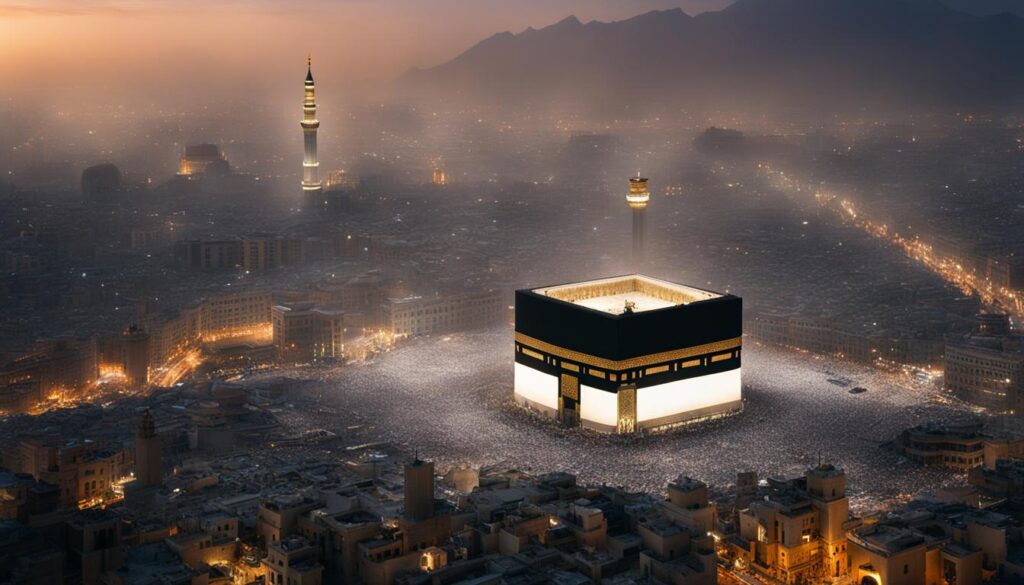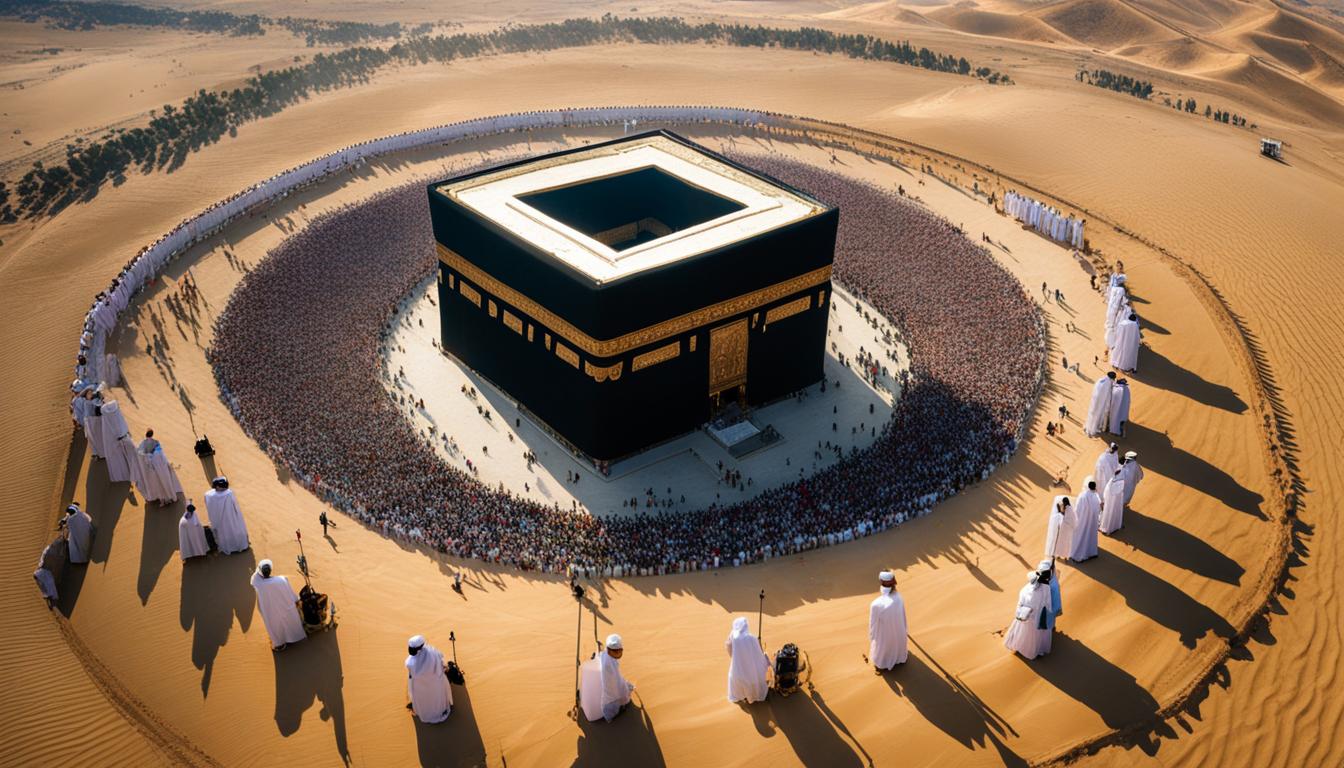Have you ever wondered why Muslims pray towards the Kaaba? The significance of the Kaaba in Muslim prayer and the direction of prayer in Islam hold deep-rooted historical and spiritual importance. In this article, we will explore the reasons behind this practice and shed light on the mystery and controversy surrounding the Kaaba’s direction.
Key Takeaways:
- The Kaaba in Mecca is considered the holiest site in Islam and serves as the focal point for Muslims during prayer.
- Initially, the qibla, or direction of prayer, for Muslims was believed to be towards Jerusalem, but it was later changed to Mecca by Prophet Muhammad.
- Modern technology and satellite imagery have allowed researchers to study the qibla direction of ancient mosques, revealing that some early mosques pointed towards Petra in southern Jordan.
- The Kaaba symbolizes unity for Muslims worldwide and acts as a physical and spiritual center during their worship.
- While debates and speculation exist, the Kaaba remains a crucial element of Islamic faith, reminding Muslims of the fundamental principles of Islam.
The Significance of the Kaaba in Islamic Worship
The Kaaba, located in Mecca, holds great significance in Islamic worship and serves as the focal point for Muslims around the world. Muslims face the Kaaba when performing their daily prayers, known as Salah, as it is considered the holiest site in Islam. This sacred structure acts as a symbol of unity, bringing Muslims together in their devotion and reminding them of their common faith.
The Kaaba’s importance in Islamic worship can be traced back to its historical origins. According to Islamic tradition, the Kaaba was first built by Prophet Ibrahim (Abraham) and his son Ismail (Ishmael) as a place of worship for God. It has since become a center of pilgrimage and devotion for Muslims throughout history. The Kaaba’s black stone, believed to be a meteorite, adds to its significance and is venerated as a sacred relic by Muslims.
By facing the Kaaba during prayer, Muslims establish a direct connection with God and affirm their faith and devotion. It serves as a physical and spiritual focal point, symbolizing the unity of the Muslim community. The act of facing the Kaaba also serves as a constant reminder of the central principles of Islam, such as submission to God and the importance of unity among believers.
The Kaaba and Its Role in Islamic Worship
The Kaaba’s significance goes beyond its physical structure. It holds immense spiritual value for Muslims, who consider it the house of God and a symbol of their faith. The act of facing the Kaaba during prayer is a powerful representation of this connection, allowing Muslims to deepen their spiritual journey and find solace in their worship.
In conclusion, the Kaaba’s role in Islamic worship is profound and deeply rooted in the traditions and beliefs of Muslims. It serves as a symbol of unity, a physical and spiritual focal point, and a reminder of the fundamental principles of Islam. By facing the Kaaba, Muslims establish a direct connection with God and reaffirm their faith, finding solace and strength in their devotion.
The Historical and Spiritual Significance of the Kaaba
The historical and spiritual significance of the Kaaba in Islam is deeply rooted in Islamic tradition and beliefs. Muslims face the Kaaba while praying because it is considered the house of God and the focal point towards which all Muslims should direct their worship. The Kaaba serves as a constant reminder of the unity and equality of all Muslims, regardless of their social or geographic differences. The qibla direction, which is the direction of prayer, plays a fundamental role in Islamic worship, with the Kaaba guiding Muslims in their connection with God during prayer.
The reasons behind Muslims facing the Kaaba while praying are multifaceted. Firstly, the Kaaba is believed to be the first house of worship on Earth, built by Prophet Ibrahim and his son Ismail. It symbolizes the oneness of God and the unity of all Muslims around the world. Secondly, facing the Kaaba during prayer helps create a sense of global community among Muslims, as it aligns everyone towards a common focal point. It reinforces the belief that all Muslims are equal in the eyes of God, regardless of their nationality, race, or status. Finally, the qibla direction towards the Kaaba serves as a spiritual compass, guiding Muslims in their devotion and connection with God.
The Role of the Kaaba in Guiding Muslim Prayer
The Kaaba’s role in guiding Muslim prayer extends beyond its physical presence. It represents a spiritual connection between believers and the divine. When Muslims face the Kaaba during prayer, they align themselves with the historical and spiritual significance of this sacred site. The act of facing the Kaaba helps Muslims concentrate and focus their minds on God, creating a sense of reverence and humility. It serves as a visible reminder of the direction in which Muslims should direct their hearts and devotion.
The Mystery and Controversy Surrounding the Kaaba’s Direction
The direction of prayer towards the Kaaba in Mecca has long been a fundamental practice in Islam. However, recent technological advancements and archaeological discoveries have raised questions and sparked controversy regarding the true direction of the Kaaba and its significance in Muslim worship.
By harnessing modern technology, researchers have been able to study the qibla direction of ancient mosques with greater precision. Tools like satellite imagery and online platforms allow for a more comprehensive analysis of historical records and manuscripts, providing new insights into the orientation of early mosques.
One intriguing finding is that some early mosques appear to have pointed towards Petra, a city in southern Jordan, instead of Mecca. This discrepancy has led to heated debates and speculation about the accuracy of historical narratives and the influence of cultural and political factors on the establishment of the qibla direction.

Unveiling the Role of Technology and Historical Discrepancies
The use of technology has enabled researchers to delve deeper into the mystery surrounding the holy city of Mecca and its direction in Islamic worship. Ancient manuscripts and satellite imagery have become invaluable tools in exploring the historical context and potential variations in the orientation of early mosques.
While some scholars argue that the alignment towards Petra may be due to historical discrepancies or temporal adjustments, others suggest that it may reflect the evolution of Islamic practices over time. The influence of political and societal factors, as well as the symbolic importance of Mecca in later Islamic history, cannot be disregarded when discussing the controversy surrounding the Kaaba’s direction.
The Implications for Islamic Faith and Practice
These controversial findings have significant implications for the Islamic community today. While the direction of prayer towards Mecca remains an essential pillar of Muslim faith, the ongoing discussions about the historical accuracy of the qibla direction highlight the complexity and evolution of religious practices.
Ultimately, the Kaaba continues to hold an unparalleled spiritual significance in Islam, serving as a symbol of unity and devotion for Muslims worldwide. The mysteries and controversies surrounding its direction only serve to deepen the understanding of the rich heritage and diverse interpretations within the Islamic faith.
The Mystery and Controversy Surrounding the Kaaba’s Direction
The evidence presented has led to some intriguing speculation and controversy surrounding the true direction of prayer in Islam. While it is widely believed that the Kaaba in Mecca is the qibla, or direction of prayer, for Muslims, recent research suggests otherwise. It has been discovered that early mosques, dating back to the first century of Islam, actually aligned with the city of Petra in southern Jordan, instead of Mecca. This finding raises questions about the historical accuracy of our understanding of the qibla direction and the role of the Kaaba in Muslim worship.
Questioning Historical Narratives
The revelation that the early mosques aligned with Petra challenges the prevailing historical narratives surrounding the direction of prayer in Islam. It prompts us to reexamine our assumptions and reassess the sources upon which our knowledge is based. This discovery calls for a deeper exploration of ancient manuscripts, archaeological findings, and religious texts to gain a more comprehensive understanding of the origins and development of Islamic practices.
Potential Implications for Muslims Today
If the evidence of mosques aligning with Petra is indeed accurate, it raises significant implications for Muslims today. It challenges the deeply ingrained beliefs and rituals of over a billion Muslims who have been praying towards the Kaaba in Mecca. This revelation may prompt a reassessment of the importance and true significance of the Kaaba in Islamic faith and worship. It also invites a broader conversation within the Islamic community about the role of historical accuracy and the potential evolution of religious practices in light of new knowledge.
Conclusion
The direction of prayer towards the Kaaba in Mecca holds immense significance in Islamic faith and worship. Despite debates and speculation surrounding the historical accuracy of the qibla direction, the Kaaba remains a powerful symbol of unity for Muslims worldwide.
Whether the initial direction of prayer was towards Jerusalem or Petra, the Kaaba serves as a focal point in Muslim prayer, guiding believers in their connection with God. It represents the fundamental principles of Islam, emphasizing unity, equality, and devotion.
The discovery of potential historical discrepancies and the role of technology in studying religious practices offer new perspectives for understanding the rich and complex heritage of Islam. While these findings may raise questions, they do not diminish the role of the Kaaba in Islamic faith.
In conclusion, the Kaaba continues to play a central role in Muslim worship, providing a tangible manifestation of the unity and devotion of the Islamic community. Its symbolic power transcends historical debates, serving as a steadfast monument that strengthens the faith and beliefs of Muslims worldwide.
FAQ
Why do Muslims pray towards the Kaaba?
Muslims pray towards the Kaaba because it is considered the house of God and the focal point in Islamic worship. It serves as a symbol of unity for Muslims and a reminder of their fundamental principles.
What is the significance of the Kaaba in Islamic worship?
The Kaaba is considered the holiest site in Islam and holds great importance in Muslim worship. Muslims around the world face the Kaaba when performing their daily prayers, known as Salah. It serves as a physical and spiritual focal point, symbolizing unity among Muslims.
Why do Muslims face the Kaaba while praying?
Muslims face the Kaaba while praying because it is believed to be the direction towards which Prophet Muhammad changed the qibla, or direction of prayer, for Muslims. It is considered the house of God and the focal point towards which all Muslims should direct their worship.
What is the historical significance of the Kaaba in Islam?
The Kaaba is believed to have been built by Prophet Ibrahim (Abraham) and his son Ismail (Ishmael) and has been a place of pilgrimage and devotion since ancient times. It holds deep historical and spiritual significance in Islamic tradition and is considered the holiest site in Islam.
Is there controversy surrounding the Kaaba’s direction?
There has been speculation and controversy regarding the true direction of prayer in Islam. Some researchers suggest that early mosques actually pointed towards Petra in southern Jordan instead of Mecca. This raises questions about historical discrepancies and the potential influence of ancient manuscripts and satellite imagery on our understanding of the Kaaba’s direction.
What are the implications of potential historical discrepancies?
The discovery of potential historical discrepancies raises important questions for the Islamic community today. It has led some scholars to question the accuracy of historical narratives and suggests that over a billion Muslims may have been praying in the wrong direction. This challenges long-held beliefs and practices in Islam and prompts further exploration and discussion.

